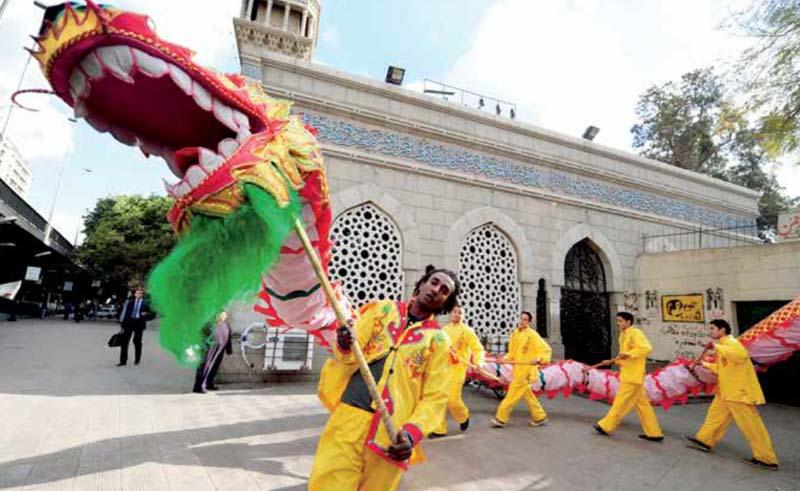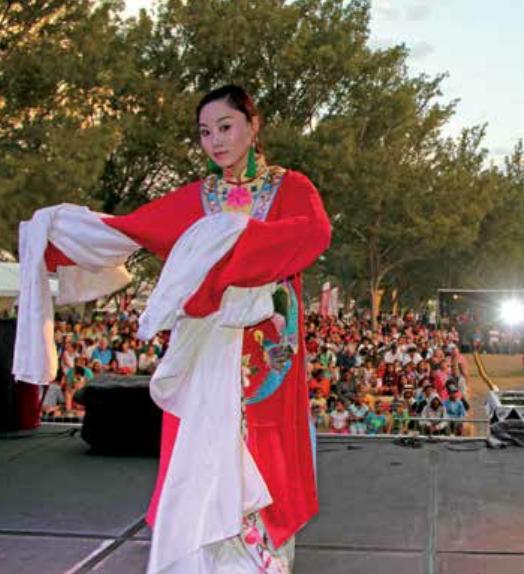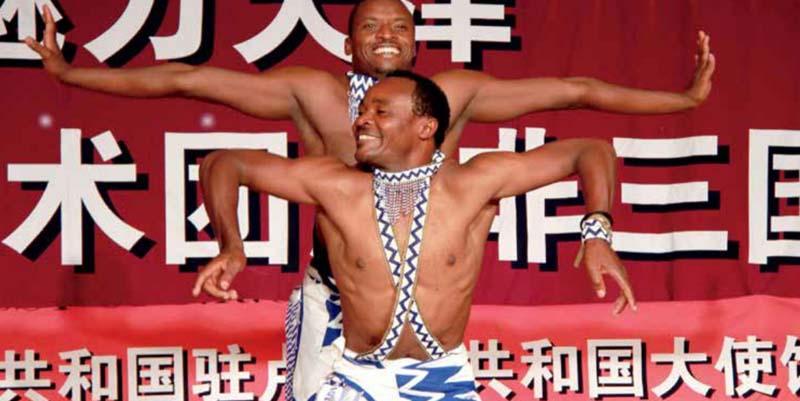Creative exchange
By liu Jian



It would have made edward said tingatinga both proud and glad to know that the traditional African tribal art he gave a fresh lease of life to will be traveling to China this month. Tingatinga, which started as a tribal art used by Tanzanians to brighten up their walls, received a boost in the late 1960s when Edward Said Tingatinga began painting in the style in Dar es Salaam, beginning an art movement. Today, the school of indigenous painting has thousands of artists, not just in Tanzania but also in Kenya and the neighboring East African countries and is one of the most popular East African souvenir arts as well.
This month, Chinese art lovers will be introduced to the art at the African Impression art exhibition to be held at the China National Museum of Women and Children in Beijing from May 6-12. Visitors will savor a visual feast of 20 Tingatinga paintings by Tanzanian artists as well as 40 more by nearly 20 Chinese painters, done during their trips to Africa. The synergy between African and Chinese artists will be seen in the ink and wash paintings in the Chinese style, executed by Chinese artist Xu Qiping and her Tanzanian students. Xu taught Chinese calligraphy and painting to students in the Tanzania China Cultural Center and the Department of Fine and Performing Arts at the University of Dar es Salaam from November to December last year.
There are other Sino-African interactive programs scheduled in May. The MusicFest art troupe from South Africa will perform in multiple venues in the Chinese capital - Chaoyang Park, the Peking University and the National Center for the Performing Arts. Together with Chinese artists, the troupe will also take part in the 2016 Meet in Beijing Arts Festival, the international festival hosted annually by Chinas Ministry of Culture, Beijing Municipal Government and the State Administration of Press, Publication, Radio, Film and Television that has become an established Chinese culture brand.
In September, musicians, singers and dancers from African countries will showcase their art at the African Night show in Beijing.
The interactions are timely as 2016 marks the fourth year of the African Cultures in Focus program. To be inaugurated on May 6, the eight-month program will bring more African art and performances to China and provide an opportunity for Chinese people to learn more about the rich and diverse cultures of a continent that despite its geographical distance is one of Chinas biggest trade and diplomacy partners. By knowing more about each others art and culture, the two sides would be able to understand each other better.
Academic exchanges such as seminars and visiting artist programs have also been planned. Several African artists will attend art workshops at Chinese art institutions in Chengdu, capital city of southwest Chinas Sichuan Province, in July, creating art with a China theme.
The African Cultures in Focus program is held every second year, alternating with the Chinese Culture in Focus event, hosted by the Ministry of Culture. Held since 2008, they have become a significant brand and platform for cultural exchanges between China and Africa. The first program was held in Shenzhen, a city in south China. But now they cover more cities with diversified events.
Chinese had a comprehensive opportunity to learn more about South Africa during the Year of South Africa in China program in 2014, while South Africans had the chance to experience Chinese culture up close during the Year of China in South Africa in 2015.
“South Africans enjoyed the rich Chinese cultural experience through ballet, art works, literature, films and theaters, photo exhibitions, acrobatics and martial arts performances,” said Tebogo Lefifi, China Chief Representative of Brand South Africa, a South African agency promoting the country. “These performances were driven at the local level through 28 twin agreements between provinces and cities. Engagement at the local level deepens people-topeople relations, which are often lacking in ChinaAfrica relations and exchanges.”
Celebrations without borders
Suleman Dussa, a Tanzanian hotel manager, remembers his eventful first Chinese New Year in China in 2014 vividly. “I traveled, like, five provinces, driving 80 hours nonstop, going to my friends home to celebrate Spring Festival (the Chinese New Year which falls in February),” he recalled.
Back home in 2015, he still continues to participate in the celebrations, joining the diaspora of nearly 50,000 Chinese working, studying and living in Tanzania.
“I like the Spring Festival because of the things that come with it,” he added. “We get a lot of invitations, we do a lot of activities, and we get to know a lot of people. The activities bring families and friends together. I love the things we do together during the Spring Festival.
“The more people get to know each other, understand each other and respect each others cultures, the easier it is to live together,” he said.
This year, the Chinese New Year was celebrated in Dar es Salaam. The celebrations blended Chinese traditional arts and Tanzanian arts, including singing, acrobatics, music and martial arts performances.
“It is a perfect combination of the two different cultures and builds a good connection between the two countries,” said Gao Wei, Executive Director with the China Cultural Office in Tanzania. Gao also said the festival aims to promote Tanzanian peoples understanding of Chinese culture and enable them to join in the traditional merrymaking.
The Dar es Salaam Spring Festival is part of the Happy Chinese New Year program organized by the Chinese Ministry of Culture across the globe. In its seventh year, the event has seen over 2,100 cultural activities in nearly 400 cities in 140 countries and regions.
Temple training
Yuan Daxi, Deputy Director of the Division of Africa Affairs at the Ministry of Cultures Bureau for External Cultural Relations, said a series of exchange programs have been organized to provide human resources training in African countries. Four training bases have been established in China. They provide training in martial arts, embroidery, making bamboo products, ceramic pottery making, creative designing and cultural heritage protection.
“They are in line with the commitment made by Chinese and African leaders at the Sixth Ministerial Conference of the Forum on China-Africa Cooperation (FOCAC) in Johannesburg in December 2015,”Yuan said.
According to the FOCAC Johannesburg Action Plan (2016-18), the Chinese side will establish 10 culture training bases for Africa and implement the One Thousand People Program for culture training in Africa.
In 2012, Chinas Ministry of Culture launched training in the famous Shaolin school of kungfu. Every year, about 20 African martial art lovers are invited to attend the three-month training program at the Shaolin Temple in the forested Songshan Mountain in central Chinas Henan Province. This year, the fourth batch of African students will go there for training from July to September.
“In the past, I practiced martial arts to be strong and protect myself. After receiving the training, I realized kungfu is not for fighting but is a lifestyle,”said Dalmeida Ayigan, a Togolese who attended the program last year. “Zen meditation helps me to keep a peaceful mind and teaches me how to control myself and respect others.” Ayigan hopes to teach what he learned to more people in his country.
China and African countries have several cultural heritage protection cooperation agreements. Last September, the Second China-Africa Cultural Heritage Preservation Forum was held in Chengdu in southwest Chinas Sichuan Province. Experts and officials from China and 14 African countries came together to discuss cultural heritage protection.
Like China, African countries also have a rich cultural heritage. But due to turmoil and natural disasters, Africas measures to conserve the legacy have been inadequate. “China has rich and varied cultural heritages which are well protected. There is huge potential for cooperation in cultural heritage protection between us,” Nabil Kallala, Director General of the National Heritage Institute of Tunisia, told ChinAfrica at the forum.
Expanded exchanges
Along with the economic development of China and African countries, peoples cultural needs have diversified and increased. Consequently, the forms of cultural exchanges have been enriched and expanded, Yuan said.
“China-Africa cultural exchanges have trans-formed from a mere government initiative to a new pattern characterized by the governments leading role and the participation of all sectors of society,”wrote Luo Shugang, Chinas Minister of Culture, in an article.
Chinese provinces and municipalities extensively take part in China-Africa cultural exchanges in cooperation with the ministry. Since 2012, a total of 14 provinces and municipalities have conducted nearly 100 cultural programs with 26 African countries, according to Luo.
Ministries, local cultural bureaus, companies, non-governmental organizations, research institutions, art troupes and mass media have all been participating in the exchanges.
Film and television exchanges and cooperation have also been strengthened. With popular Chinese TV series being aired in African countries after being dubbed in major African languages, African audiences can know more about China.
The 36-episode comedy Mao Doudou and Her Sweet Days, which is about a modern Chinese couple and their relationship with each others families, was dubbed in Swahili and shown in East African countries in 2011.
Following the success of this TV series, more Chinese soaps and movies were dubbed in Swahili, Hausa, English, French, Arabic and Portuguese for broadcasting in Africa and gained popularity with the local audiences.
The funny and interesting plots lead African audiences to look into Chinese peoples everyday lives. “Family relationships are a common subject for people anywhere in the world. They help us to better understand todays China,” said Mohamedi Omari Kaboba, a Tanzanian artist.
“I watched many Chinese kungfu movies before I came to China. I used to think all Chinese people were kungfu practitioners. But when I watched the TV series, I saw a different China, and young peoples love stories are just like the ones in my country,”said Nastru Sani, a 34-year-old Nigerian.
“By understanding others cultures, people from different countries can have heart-to-heart communication,” said Li Jiashan, Executive Dean of the National Institute of Cultural Development at Beijing International Studies University.
As part of the efforts to enhance mutual understanding and cooperation, a research center to study African films and television programs was set up in Zhejiang Normal University in east China in December 2015. It focuses on academic exchanges and developing skills, according to Liu Hongwu, head of the center.

